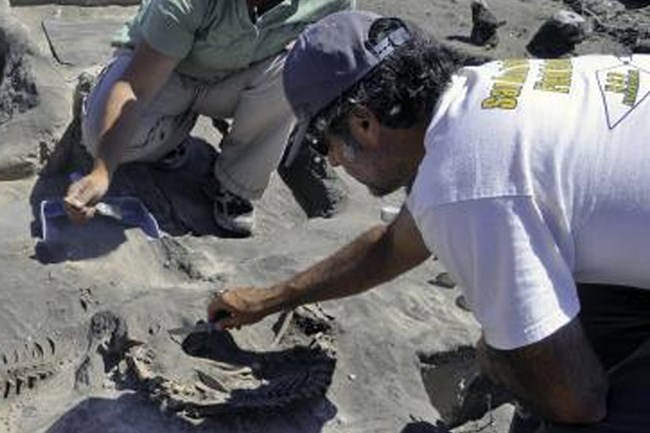
Chapter 2
Dr. René Vellanoweth, Professor of Anthropology, California State University, Los Angeles, has conducted many archeology investigations on San Nicolas Island. Dr. Vellanoweth discusses his research.
I have spent my career searching for clues about how the native people of San Nicolas Island lived before Europeans introduced a new way of life to the region. The island's more than 550 archeological sites provide valuable information about native people's daily and social lives.
Each year I return with my students to study these sites. We spend time surveying the island (that is, walking around it), taking measurements and drawing maps of new sites, and updating maps of old ones.
Over the years we have investigated a variety of sites, from large villages with pit houses, communal lodges, cemeteries, and big trash heaps to small, temporary camps where only a scattering of shells or stone tools still remain.
Although we have made some incredible discoveries, some of the most exciting include the time we found rare 5,000-year-old shell beads carved in a very distinctive style.
Another time while excavating a village site, we found the remains of camp fires and feasting pits; animal burials; arrow points, stone drills, and grinding stones; and crystals, pigments, pipes, stacked stones, and other ceremonial objects used by religious leaders.
-
Listen to chapter 2 entry
Learn about an archeologist’s research on San Nicolas Island.
Chapter 25
Dr. René Vellanoweth, Professor of Anthropology, California State University, Los Angeles, discusses the dog burials he has found on San Nicolas Island.
Our investigations on San Nicolas Island have revealed quite a bit about the Native Americans who lived there for more than 10,000 years. We have learned that they relied heavily on the sea and the island for food and the raw materials needed for making tools, weapons, and other objects. They also traded with their nearby and distant neighbors to acquire things they needed or desired but could not get from the island itself.
Our work has revealed that the native people brought the domesticated dog with them from the mainland, and that they developed a close relationship with human’s “best friend.” We know the native islanders and dogs lived and worked side-by-side based on the dog burials we have excavated.
In one case, my students and I found a dog burial that had two female puppies with the remains of their last meals still intact within the stomach portions of their skeletons. In the same site, located about 30 feet from this double dog burial, we incredibly found a triple dog burial.
The three dogs in the triple dog burial were all full-grown adult males. The bones of the male dogs show evidence that they were working dogs, trained by the islanders to help hunt and carry things in packs and sleds.
That the dogs were buried in an area of the site equivalent to a church or temple speaks volumes about the close, personal nature of the relationship between the islanders and their dogs.
-
Listen to chapter 25 entry
Learn about dog burials on San Nicolas Island.
Last updated: November 29, 2018
